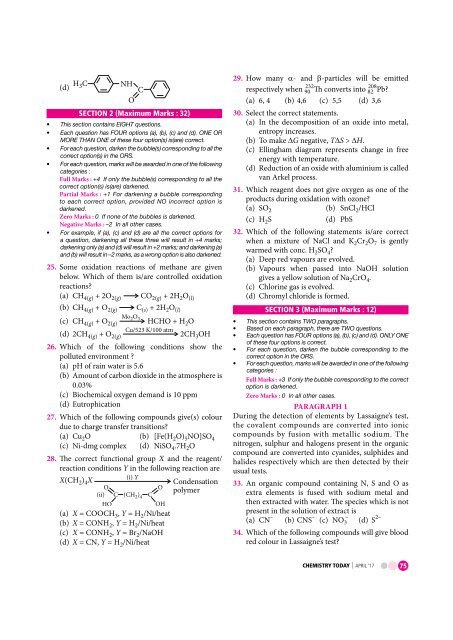Chemistry_Today_April_2017_vk_com_stopthepress
You also want an ePaper? Increase the reach of your titles
YUMPU automatically turns print PDFs into web optimized ePapers that Google loves.
(d) HC 3 NH C<br />
O<br />
SECTION 2 (Maximum Marks : 32)<br />
• This section contains EIGHT questions.<br />
• Each question has FOUR options (a), (b), (c) and (d). ONE OR<br />
MORE THAN ONE of these four option(s) is(are) correct.<br />
• For each question, darken the bubble(s) corresponding to all the<br />
correct option(s) in the ORS.<br />
• For each question, marks will be awarded in one of the following<br />
categories :<br />
Full Marks : +4 If only the bubble(s) corresponding to all the<br />
correct option(s) is(are) darkened.<br />
Partial Marks : +1 For darkening a bubble corresponding<br />
to each correct option, provided NO incorrect option is<br />
darkened.<br />
Zero Marks : 0 If none of the bubbles is darkened.<br />
Negative Marks : –2 In all other cases.<br />
• For example, if (a), (c) and (d) are all the correct options for<br />
a question, darkening all these three will result in +4 marks;<br />
darkening only (a) and (d) will result in +2 marks; and darkening (a)<br />
and (b) will result in –2 marks, as a wrong option is also darkened.<br />
25. Some oxidation reactions of methane are given<br />
below. Which of them is/are controlled oxidation<br />
reactions?<br />
(a) CH 4(g) + 2O 2(g) CO 2(g) + 2H 2 O (l)<br />
(b) CH 4(g) + O 2(g) C (s) + 2H 2 O (l)<br />
(c) CH 4(g) + O Mo 2 O 3<br />
2(g) HCHO + H 2 O<br />
Cu/523 K/100 atm<br />
(d) 2CH 4(g) + O 2(g) 2CH 3 OH<br />
26. Which of the following conditions show the<br />
polluted environment ?<br />
(a) pH of rain water is 5.6<br />
(b) Amount of carbon dioxide in the atmosphere is<br />
0.03%<br />
(c) Biochemical oxygen demand is 10 ppm<br />
(d) Eutrophication<br />
27. Which of the following <strong>com</strong>pounds give(s) colour<br />
due to charge transfer transitions?<br />
(a) Cu 2 O (b) [Fe(H 2 O) 5 NO]SO 4<br />
(c) Ni-dmg <strong>com</strong>plex (d) NiSO 4 .7H 2 O<br />
28. The correct functional group X and the reagent/<br />
reaction conditions Y in the following reaction are<br />
(i) Y<br />
X(CH 2 ) 4 X<br />
Condensation<br />
O<br />
O<br />
polymer<br />
(ii) C (CH 24 ) C<br />
HO<br />
OH<br />
(a) X = COOCH 3 , Y = H 2 /Ni/heat<br />
(b) X = CONH 2 , Y = H 2 /Ni/heat<br />
(c) X = CONH 2 , Y = Br 2 /NaOH<br />
(d) X = CN, Y = H 2 /Ni/heat<br />
29. How many a- and b-particles will be emitted<br />
respectively when 232 90 Th converts into 208 82 Pb?<br />
(a) 6, 4 (b) 4,6 (c) 5,5 (d) 3,6<br />
30. Select the correct statements.<br />
(a) In the de<strong>com</strong>position of an oxide into metal,<br />
entropy increases.<br />
(b) To make DG negative, TDS > DH.<br />
(c) Ellingham diagram represents change in free<br />
energy with temperature.<br />
(d) Reduction of an oxide with aluminium is called<br />
van Arkel process.<br />
31. Which reagent does not give oxygen as one of the<br />
products during oxidation with ozone?<br />
(a) SO 2<br />
(b) SnCl 2 /HCl<br />
(c) H 2 S<br />
(d) PbS<br />
32. Which of the following statements is/are correct<br />
when a mixture of NaCl and K 2 Cr 2 O 7 is gently<br />
warmed with conc. H 2 SO 4 ?<br />
(a) Deep red vapours are evolved.<br />
(b) Vapours when passed into NaOH solution<br />
gives a yellow solution of Na 2 CrO 4 .<br />
(c) Chlorine gas is evolved.<br />
(d) Chromyl chloride is formed.<br />
SECTION 3 (Maximum Marks : 12)<br />
• This section contains TO paragraphs.<br />
• ased on each paragraph, there are TO questions.<br />
• Each question has FOUR options (a), (b), (c) and (d). ONLY ONE<br />
of these four options is correct.<br />
• For each question, darken the bubble corresponding to the<br />
correct option in the ORS.<br />
• For each question, marks will be awarded in one of the following<br />
categories :<br />
Full Marks : +3 If only the bubble corresponding to the correct<br />
option is darkened.<br />
Zero Marks : 0 In all other cases.<br />
PARAGRAPH 1<br />
During the detection of elements by Lassaigne’s test,<br />
the covalent <strong>com</strong>pounds are converted into ionic<br />
<strong>com</strong>pounds by fusion with metallic sodium. The<br />
nitrogen, sulphur and halogens present in the organic<br />
<strong>com</strong>pound are converted into cyanides, sulphides and<br />
halides respectively which are then detected by their<br />
usual tests.<br />
33. An organic <strong>com</strong>pound containing N, S and O as<br />
extra elements is fused with sodium metal and<br />
then extracted with water. The species which is not<br />
present in the solution of extract is<br />
(a) CN – (b) CNS – –<br />
(c) NO 3 (d) S 2–<br />
34. Which of the following <strong>com</strong>pounds will give blood<br />
red colour in Lassaigne’s test?<br />
CHEMISTRY TODAY | APRIL ‘17 75


